Archive for August, 2016
‘Rik Wouters & The Private Utopia’ on Europeana Fashion Tumblr
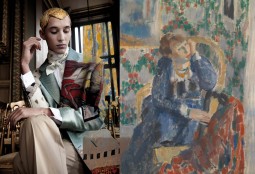
MoMu is the new curator of Europeana Fashion Tumblr. This September, in concurrence with the museum’s latest exhibition ‘Rik Wouters & The Private Utopia’, the Europeana Fashion Tumblr page will showcase pictures and artworks unveiling the themes of the exhibition.

On the left: Walter Van Beirendonck, 'Home Sweet Home' , s/s 2014 © Ronald Stoops. On the right: Rik Wouters, 'Woman with Yellow Necklace, 1912 oil on canvas © RMFAB photo J. Geleyns | RO SCAN.
The Flemish Post-Impressionist painter Rik Wouters, whose paintings enchanted for their sense of sanctity and interiority, is the protagonist of MoMu – Fashion Museum Province of Antwerp new exhibition ‘Rik Wouters & The Private Utopia’, that inaugurates on the 17th of September 2016. Realized in collaboration with the Royal Museum of Fine Arts Antwerp, the exhibition commemorates the 100th anniversary of the death of the painter.
The artist depicted in his paintings simple domestic scenes with his expressive brush strokes, unfinished style and emphasis on lighting and colour, capturing on his canvases a harmonious sense of intimacy. It is this particular sense that continues to inspire contemporary artists and designers to challenge the hectic pace of today, in search for a ‘private utopia’. This research represent the encounter of the painter and his work with some topical themes for fashion and design, which will be explored through the works of various Belgian fashion designers.
Among others, Dirk Van Saene, Bruno Pieters, Christian Wijnants, Walter Van Beirendonck, Ann Demeulemeester, Dries Van Noten, Veronique Branquinho, Martin Margiela, Marina Yee and Jan-Jan Van Essche will be featured in the exhibition, showing how they relate to the topic; they will express their particular point of view through the selection of fabrics and ‘slow’ techniques or by affirming their outstanding position in the fashion world. Alongside their creations and the works of Rik Wouters, the exhibition will display the works of many contemporary artists, bridging the gap between the outputs of fashion and that of art.
MoMu’s curation of Europeana Fashion Tumblr will start on Thursday 1st September. Follow it on http://europeanafashion.tumblr.com/.
Modest and Practical: Dressed to Travel
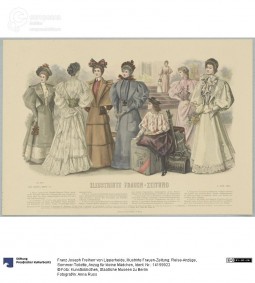
Since travelling became an accessible activity in the nineteenth century, travellers have been in search for a special attire designed to accompany them on their fares, eventually promoting new trends and customs.
Today travelling is an ordinary action that occupies much of everyone’s daily routine. By private or public means, people travel short or longer fares not only for leisure, but for work or study resons. If nowadays travelling has become an ordinary practice not requiring much more effort than to make the luggage fit the size restrictions, not that long ago travellers had the need to wear particular clothes designed precisely for travels.

Man's buff coloured travelling coat with blue plaid lining. Paris, 1825, for the Petit Courrier des Dames. Hand-coloured engraving. Courtesy Victoria and Albert Museum, CC BY NC.
The ‘travelling dress’ made its appearance in the nineteenth century, when the Industrial Revolution cut the costs of textile and clothes production, and people could afford specialized dress conceived to be worn only in specific occasions. Before this time, to travel was an occupation affordable only by the few and both higher and lower classes used to wear, in many cases, their best and most protective outerwear; from this time onwards, the improvement in the means of transport and the renovation of travel fares democratized travelling, letting more people embark on longer journeys.

Travelling dresses, summer toilettes and an ensemble for a young girl, from the 'Illustrirte Frauen-Zeitung', Franz Joseph Lipperheide, Steyrermühl. © Anna Russ. Courtesy Kunstbibliothek, Staatliche Museen zu Berlin, CC BY NC SA.
The key-words were now modesty and practicality. The ‘travelling dress’, in fact, did not only serve to protect the wearer from dust and dirt, but, whether people were travelling by train, ship or steamboat, they also needed a dress which allowed comfortable movements in a public transport – especially because the space for toilette was usually restricted or shared. In addition, it was essential for the dress to be appropriate for appearing in public among strangers.

'Ensemble de voyage' in wool and taffeta, designed by Siebenmann, 1895/1900. Courtesy Les Arts Décoratifs, all rights reserved.
The development of the travelling dress moved along with the development of the travelling system. As the public means of transportation evolved, becoming overall more comfortable, and new means, such as cars and later airplanes, appeared, the travelling dress gradually lost its functionality. Instead, a precise etiquette arose, indicating what dress to wear during a particular fare or while on a precise mean of transport.
If the ‘travelling dress’ lost its popularity in recent times, the research for the ‘ideal dress for journeys’ led fashion creators to design the most diverse and peculiar clothes. Browse the Europeana Fashion portal to find many images of the new and old travelling dress.
The Sailor Suit: history and Influences

The sailor suit, as a fashion trend, begun in the Victorian Age, developing at first as a children costume phenomenon; worn as school uniform and then for sport performances, it has kept its popularity until today.
Like many naval-inspired designs, the sailor suit originated with the British navy and was then copied into other navies. The uniform, in its most traditional form, was worn by enlisted seamen in the navy and other government funded sea services. It is also known as “Number One” uniform, its first use is for ceremony, taking this name from the old working rigs of Royal Navy sailors. Since its first introduction in 1857, it has changed continuously, to adapt to the costume evolutions of each period, but always keeping some details, and precisely the blue jean collar, as its most recognisable items.

"The Royal Navy of England and the Story of the Sailor Suit" Trade pamphlet on children's garments issued by Wm Rowe of Gosport, Cowes & London. England, ca. 1900. Printed paper. Courtesy of Victoria and Albert museum. CC BY SA
It was the 1846, when Queen Victoria was delighted, during a cruise off the Channel Islands, by seeing her four-year-old son Albert Edward, Prince of Wales, wearing a scaled-down version of the sailor suit of the Royal British Navy. His portrait was painted at the same time, right when the British Navy was the most powerful naval force in the world and its uniform had recently been standardized. So the portrait, as well as a series of engravings, made the sailor suit became popular among the British public; later it was introduced as a normal dress for both boys and girls all over the world, with some variations through different nations, according to the specific naval uniform of each country.
The sailor suit became the first popular children’s fashion trend by the 1880s, when advertisers began marketing it. For boys it consisted in a middy top with shorts or long trousers, replaced by a skirt in the feminine version. The two models had in common typical marine designs as stars, anchors or eagles, sewn on as badges. Ready-made or sewn at home, they closely resembled actual naval uniforms and used to change togheter with the development of the official ones. They were usually made of washable, sturdy fabrics like wool serge and allowed relative freedom of movement. Probably depending on this, sailor suits have soon been adopted for a variety of social situations, helping to strip away the class distinctions, a prominent aspect of British culture. Also sailor suits were frequently worn as school uniforms, probably due to their military origins and to an association with order and discipline.
Born as a thought-for-men ensemble, the sailor suit has anyway influenced women’s style in more than one way. In May 1904, Harper’s Bazaar called a sailor suit ‘the most serviceable all-around frock a girl can have’; a female version of the sailor suit, the sailor dress, was popularly known in early 20th century America. Since then, women’s fashion picked it up as casual seaside wear and it became associated with sport, summer and leisure. Elements of nautical style were absorbed into adult dress, including blue and white stripes, square sailor collars and wide, loose trousers, which are enduring elements of spring and summer dress.
Discover more sailor suits on the Europeana Fashion portal and follow @Europeanafashionofficial on Instagram to discover the sailor suit’s curation of this week!
I See Red: Fox Hunting Attire

The value of tradition in sport is linked not so much to the performance in itself – improved by new techniques and exercises, pushing the limits of body and mind – but, more often, to the presentation of both the athletes and the event as a whole. Then, the sportive act becomes a ritual, in which the form is valued as highly as the substance, and whose presentation ends to develop into a custom.

Riding and hunting clothes, Illustrations from Le Progrès, 1851, Courtesy Kunstbibliothek, Staatliche Museen zu Berlin CC BY NC SA
Sports, especially the ones with a history strongly linked to the definition of society, show their reverence to tradition in the substantial immutability of their organisation and norms. Fox Hunting is one of these sports. This kind of hunting, in its most known form, was developed by Hugo Meynell between 1753 and 1800. Etiquette was very important since the very beginning, and clothing held a central role in the outline of the ‘surface’ – that is to say, the visual identity – of the sport itself.

Hunt coats in red and blue wool with velvet collars by Johns & Pegg UK, ca. 1910-20, Courtesy Victoria and Albert Museum CC BY NC
The attire consists of the traditional red coats worn by huntsmen, masters, former masters, whippers-in. Curiously, the traditional red coats are called “pinks”. The derivation of the term is uncertain; one theory speaks about the colour of a weathered scarlet coat, but the most widely accepted links the etymology to the name of a London tailor – called Pink or Pinke – who was said to be the best at making perfect attires for hunting. The Dictionary of Phrase and Fable, E. Cobham Brewer, 1894, gives an explanation linked to the status of the sport itself: ‘The red coat in fox-hunting (or scarlet) is a badge of royal livery, hunting being ordained by Henry II. a royal sport.’ Given the meaning of red as the colour identifying roles within the participants to the hunt, it is the master who holds the power to allow his guests to wear colours; they do this in sign of appreciation for their involvement in the hunt. For those not entitled to wear colours, a black hunt coat with simple black buttons are the rule.

Three men hunting habits, 1910 ca., Courtesy Kunstbibliothek, Staatliche Museen zu Berlin CC BY NC SA
The number of buttons of the coat has a meaning as well: the Master usually wears a scarlet coat with four brass buttons, while the huntsman, the whippers-in and other staff members wear five. The colour of breeches may vary, but they are generally monochrome. Boots for the red jacket are classic English dress boots with no laces: they are either black with brown leather tops, while Butcher boots, plain black without tops, are worn with jackets of other colours. The professional staff wear the ribbons of their hunt cap down, while amateur staff and members of the field wear their ribbons up.
The Europeana Fashion portal holds many fine example of attire for fox hunting, as well as many prints and drawings depicting hunting as both a sport and a social practice. Browse the collection to have a glimpse of the clothes and accessories building the identity of this fascinating sport – and of its players.
Europeana Fashion Focus: Evening Ensemble by Germana Marucelli, 1968


Evening Ensemble by Germana Marucelli with boots by Salvatore Ferragamo, 1968. Courtesy Pitti Immagine
The outfit is an evening ensemble composed by a bodice, a waistcoat, a pair of shorts and boots. It belongs to the ‘Linea Alluminio’, Alta Moda collection for the Autumn/Winter 1968/9. The ensemble, embellished with anodized aluminium elements, was designed by Germana Marucelli and realized in collaboration with the artist Getulio Alviani.
The bodice is made of shiny leather, while the shorts are in wool. Both of them are embroidered with semicircular aluminium elements. The waistcoat is composed by ostrich feathers on a chiffon base. The ensemble is presented with boots in suède designed by Salvatore Ferragamo.
In 1948 Germana Marucelli started to collaborate with artists of her time, getting them personally involved in her creative process. The first worthy fellowship was with Pietro Zuffi, who designed motifs and prints for her clothes. The most fruitful partnerships were established at the beginning of 1970s, when she started to collaborate with Paolo Scheggi and Getulio Alviani, whose innovative and pioneering attitude helped her identify new trends.
The object is a photograph of the exhibition ‘La Sala Bianca: nascita della moda italiana’ held at Pitti Uomo 42 in 1992 and is part of Pitti Immagine Archive. The ensemble is currently on display at Museo Salvatore Ferragamo, as part of the exhibition ‘Across Art and Fashion.’ Discover more on the Europeana Fashion Portal and follow the curation by Museo Salvatore Ferragamo on Europeana Fashion Tumblr.
To dress à-la-plage: Designers and Resorts
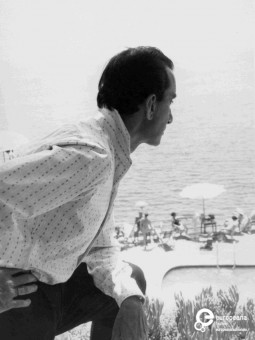
As early as it became popular to travel to fashionable seaside resorts, fashion designers and couturiers found their way in dictating the trends by the sea, not without being moved by the different landscapes and lifestyles.
Since the Roman times, the coast and seaside have been regarded as places dedicated to leisure: Julius Caesar, Nero and Hadrian were hosted in the licentious Baiae by the Tyrrhenian Sea in Italy. more recently, from the late eighteenth and early nineteenth century onwards, the European aristocracy populated the resorts towns across the old continent, spending their holidays in search for recreation and health, and making these places the stages where to perform an utterly fashionable way of life.

'Le soir à Deauville' print from 'Femina', 15th August 1903. Courtesy MoMu - Modemuseum Provincie Antwerpen, all rights reserved.
As a result, resorts became the places where the wealthy, international high class used to meet once away from the city centres. In these hubs, different families had the opportunity to confront their social costumes, traditions and, of course, fashions.

Model "Deauville", sketch for a summer day dress by Bernard et C.ie, 1914. Courtesy Kunstbibliothek, Staatliche Museen zu Berlin, CC-BY-NC-SA.
Unsurprisingly, firstly tailors and later couturiers and designers opened there their boutique and ateliers, attracted by the exclusive clienteles that frequented these beaches and the opportunities, both promotional and economical, they may provide. For instance, Jean Patou and, more remarkably, Coco Chanel, set off their boutiques in Deauville, Normandy, during the 1910s and 1920s. Later, in the early 1950s, Marquis Emilio Pucci opened his famous boutique in the prestigious resort ‘La Canzone del Mare’ in Capri, which was then the meeting point of the international jet set.

The designer Emilio Pucci in Capri, ca 1952/1953. Courtesy Emilio Pucci Archive, all rights reserved.
However, these places did not just offer a fashionable clientele to the designers that ventured to the resorts. Instead, they had been a profound source of inspiration for their designs and creations. If Emilio Pucci notoriously took his daringly bright colours from the vegetation and the waters of the isle of Capri, Coco Chanel owned to Normandy fishermans’ her striped knitted sweaters and sailor pants. Both fascinated by the sporty lifestyles of these resorts towns, so distant from the strictness of the city, designers took from these holiday places the influences that determined their modern styles.
Luggage: a travel through history!
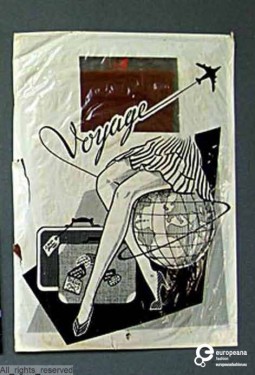
Even in the quite small time of its 120-year history, the development of luggage is surprisingly articulate and full of implications with the improvement of the social lifestyle.
Starting from the steamer trunks of bygone eras to the sticker-covered, double-locking suitcases of the 1950s and ’60s and the four-wheeled spinners of today, the development of the design and production of luggage is part of the history of human movement, reflecting how we travel and revealing what we value as travelers and human beings.
The first model of suitcase appeared around the mid-to-late 19th century, replacing the travel trunks. It was born as a massive, cumbersome box, made of wood and leather, with a heavy iron base, in order not to be crushed during travels in steamships and stagecoaches, and a covering in canvas. even though suitcases began as an afterthought in the luggage and leather goods business, in the late 19th century the beginning of mass tourism made it the very symbol of travel.

Brown suitcase for toiletries: comb, shoe horn, hand schoenoprekker, button hook, hair brush, clothes brush, toothbrush, soap box, sweeper, two boxes for jewelry, hand mirror. 1930/1935. Courtesy of Centraal Museum. All rights reserved
Since the early age of the luggage industry, some companies made a name for themselves with their high-end products. At first it was Louis Vuitton who, in the mid-1850s, introduced his pioneering slat trunk, with a canvas sheath, well-designed drawers and a flat top that made stacking much easier.

Woman in plaid skirt and heels reflected in the mirror on the street with two suitcases. 1949/1951. Courtesy of Stiftelsen Nordiska museet. CC BY NC ND
In the early 20th century, the ‘dress-suit case’ was only one of countless styles of container that travelers could buy, as steamer trunks, club bags or everyday portable wardrobes. Tourism was a decidedly upper-class phenomenon and rich people, who used to travel with their servants, could rely on an army of hired hands to carry luggages. When trunks went out of style, suitcases took on practical and cultural significance, becoming a literary symbol for both mobility and mystery.

Pair of nylon stockings in packaging. "Voyage". 1955/1965. Courtesy of ModeMuseum Provincie Antwerpen. All rights reserved
With the rapid expansion in automobile travel during in the 1920s, and a more gradual expansion of air travel a couple decades later, they had to get lighter and cheaper and cardboard and plastic models were launched on the market, emphasizing ‘modern’ materials and convenience. But they were still far from the most recent products.
The modern suitcases feature large pieces of hard plastic and are built with synthetic materials and fabrics; zippers have replaced clasps and few of them are specifically waterproof. Last but not least, the most of them have wheels. All these developments came in the last half-century, with the onset of mass aviation. The suitcase had to adapt to fit the requirements of flying travels, which comprehend half a mile of walking during check-in, layovers and arrival and specific proportions and size limits of the storage areas. During the 2000s luggage manifacturers released new lightweight models with the latest tech recoveries to stay competitive. The ultra light and highly durable polycarbonate, the ergonomically designed bags and backpacks, GPS-enabled technology and luggage that charges and protects tech gadgets, just demonstrate that the improvement of luggage features evolves with changes in lifestyle, paying attention not only to the content but, interestingly, to the container as well.
Discover more amazing suitcases and luggage on Europeana Fashion portal!
On Cities on Clothes: Moschino ‘Cruise me Baby’ collections
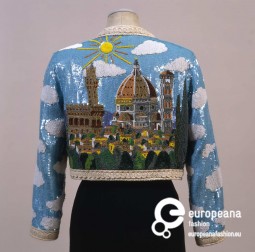
Cities hold a pivotal role in the fashion system. Not only because of their position as catalysts in the production, promotion and distribution of fashion; also, in their being the places where fashion, as a social phenomenon, blossoms, being shaped by the identity of the city itself and by that of its Inhabitants.
The specificities of each city allow to consider its active role in the creative process, and most of the times the stereotype becomes the basis on which to work in order to reinvent itself without forgetting the roots. The central importance of the city, as a set of special features and history, is clear in the words of the storyteller as well as in the mind of the image-maker, who builds an aesthetic on the glimpses and perspectives that can be encountered while wandering around.

Jacket from Moschino 'Cruise me Baby' collection, S/S 1993, Courtesy Galleria del Costume di Palazzo Pitti
Sometimes, cities are de-materialised – and then re-materialised again – during the creative process, and end to become messages inscribed on the clothes. Many are the designers who used cities on their clothes, rethinking them as embroideries, prints, patterns; the cities used to ‘inspire’ the designs are never chosen without a real reason: most of the times, it is for the kind of atmosphere they evoke, and for the bond the designer has with that particular place. This is what happened with Moschino and the ‘Cruise me Baby’ collections of the first half of the 1990s.
Moschino launched its ‘Cruise me Baby’ line at the beginning of the 1990s. Between 1991 and 1994, the collections were dedicated to some of the most important Italian cities; Naples, Venice, Florence, Pisa and Rome became flat patterns, or were sublimated in symbols to ornate jackets, waistcoats, shirts and dresses; Florence, for instance, was both represented as a landscape, displaying the sublime architecture of the city and its amazing panorama, and as sign, the lily, historical symbol of the city, multiplied as a quasi-geometric pattern, next to black and white squares and dreamy clouds.

Jacket from Moschino 'Cruise me Baby' collection, S/S 1993, Courtesy Galleria del Costume di Palazzo Pitti
The style of the collections was true to the identity of the brand: a familiar cheekiness, refined in its being overtly tacky. The designs were also a love letter to Italy, celebrating the many faces of a Country that made of its regional diversities its strength, playing on the differences to build a varied international recognisability.
The clothes Moschino designed can be considered like postcards: they can be seen as patriotic banners to be preserved and showcased, or they can be a more intimate object, whose material qualities can hold memories and recall sensations. In both ways, the city itself becomes the message, and the use of the object comes after the meaning the wearer gives to the city he or she has decided to wear.
Scoring the Set. Jean Patou and the tennis court

In and out of the game field, Jean Patou was an innovator, shaping his definition of modernity with designs for sport and leisure.
Tennis, in its modern form, developed in the second half of nineteenth century, when Harry Gem and Augurio Perera founded the first tennis club in Lemmington Spa in 1872. Around the same time, two other people developed similar ideas: Army officer Major Walter Clopton Wingfield patented a similar game, called sphairistikè or ‘the art of playing ball’, at a garden party in his friends’ estate in Wales; Mary Ewing Outerbridge, coming home to the US from Bermuda, brought a sphairistikè set and laid out a tennis court at the Staten Island Cricket Club.

Sport ensemble by Jean Patou and Muguette Buhler, ca. 1934, Courtesy Les Arts Decoratifs, all rights reserved
The game gained a certain popularity, and as its rules evolved, many fashion designers engaged in creating dedicated ensembles. Jean Patou was one of them. Born in 1880 in Normandy, he opened his first atelier ‘Maison Perry’ in 1912 in Paris, closing it in 1914 to serve France during WW1. He reopened his boutique in 1919 and, similarly to his contemporaries Coco Chanel and Lucien Lelong, he became attracted to the new ‘active lifestyle’ fashionable in Europe and the US. Being an active person himself, the designer understood the need to study athletes and their movements to design clothes that would help them in their performances. So, in 1922 he entered the market with a line of sport and activewear, which he continued well into the 1930s.
One year before launching his activewear line, Jean Patou already ventured into sportswear, designing an innovative tennis uniform for the French athlete and Wimbledon player Suzanne Lenglen, to whom he was introduced by his brother-in-law Raymond Barbas, member of the French national team. Lenglen was a talented player; she won Wimbledon and the French Open six times each, setting a record that remained untouched for almost fifty years.
The ensemble Jean Patou designed for Lenglen allowed her to leap towards the ball and swing her racket with a full range of motion. Made of a white, pleated, knee-length skirt, a white, sleeveless cardigan and an orange headband, the outfit was considered quite a dare. The length of the skirt was seen to be socially inconvenient, as it was replacing the hat with a headband and exposing her nude arms. However, Suzanne Lenglen was not one to stick to the rules. With her emancipated flair and charismatic personality, she challenged the norms, values and restraints of ‘femininity’ within society as tenaciously as on the tennis field. A liberated and active woman, the clothes designed by Patou reflected her spirit both in and off the court.
The Emilio Pucci’s Hostess Collection at the Osaka Expo ‘70
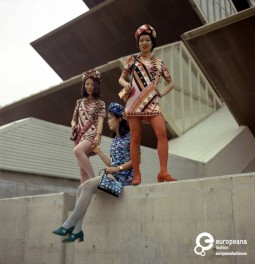
Marquise Emilio Pucci di Barsento, founder of the Maison based in Palazzo Pucci in via de’ Pucci, in the heart of Florence, was driven in his work as fashion designer by the desire to produce clothes that gave women the possibility to move freely, enjoying every activity they were up to.
Coming from a noble and influent family of Florence, he discovered his passion for fashion design in Zermatt, Switzerland, where he spent his time giving ski lessons, after a career as air force pilot during WW2. Trying to find a way to simplify movements during ski performances, in 1947 he designed a streamlined ski outfit, initially for himself and then for his learners and friends. The outfit was photographed by a fashion photographer and published on Harper’s Bazaar USA – and in this way Emilio Pucci came out on the fashion scene!
With the aim to create a wardrobe for women made of weightless and more comfortable clothes, he started to collaborate with expert fabric manufacturers in Italy; he succesfully pioneered and patented revolutionary stretch fabrics that replaced the heavy and rigid fabrics that were commonly used at the time. The culmination of his work arrived in 1950s, when he began developing his peculiar style with signature prints. Graphic, abstract designs and geometric patterns inspired by cities and monuments were printed on his fabrics and used to create a very peculiar and original style. His modern sportswear design with an elegant allure, gained him the big international success and the title ‘Prince of Prints’.
Following his will to design clothes that were at once functional and striking, in 1965 he happily started collaborating with Braniff International Airways to design the staff uniforms. The US major airway company Braniff Airways, Inc., part of Braniff International Airways, was up and running from 1930 to 1982, flying in the Midwest and the south-west of the US, Panama and, in its latest years, also in Asia and Europe.
Brightly colored and absolutely original, the Braniff uniforms created by Emilio Pucci, with their ‘futuristic’ appeal, were certainly innovative in the range of international uniform. Emilio Pucci was in charge of the uniforms of the company from 1965 to 1977, time in which he produced more than one iconic collection. 1970 was the year of Expo ‘70, a world’s fair held in Suita, Osaka, whose theme was “Progress and Harmony for Mankind”; at the time, Braniff International had already started to work with Asia. Emilio Pucci took the opportunity to participate to the event and presented the Braniff uniforms with a brand new design, showing simple shapes decorated with his peculiar prints. The result was utterly glamourous, thanks to the magnificent color mix and unique cut of the ensembles.
Discover more pictures of the “Hostess” Collection at the Osaka Expo on Europeana Fashion portal!






